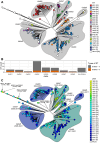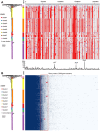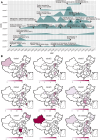Origin of Neisseria meningitidis clonal complex 4821
- PMID: 40476506
- PMCID: PMC12180329
- DOI: 10.1080/22221751.2025.2515461
Origin of Neisseria meningitidis clonal complex 4821
Abstract
Neisseria meningitidis (N. meningitidis) is the causative agent of human invasive meningococcal disease (IMD). Clonal complex (CC) 4821 is a unique genetic cluster of N. meningitidis that emerged two decades ago in Anhui Province, China and became the predominant cluster. However, the evolutionary origin of CC4821 remains unclear. Herein, a distinct CC4821 clade was identified by a comprehensive cgMLST analysis of 26,801 N. meningitidis genomes. The CC4821 clade comprised 388 N. meningitidis isolates, with 364 assigned to CC4821, 1 assigned to CC8, and 23 unassigned (UA), as they could not be assigned to any defined CC. The phylogenetic analysis of the CC4821 clade revealed that six UA isolates, including the UA isolate NmR29026 collected in 1966 from Liaoning Province, China, occupied a basal position compared to all isolates within the CC4821 clade, indicating that CC4821 originated in the 1960s. Eight subclades (clades 1-8) were recognized within the CC4821 clade. Clades 1-4 have been present since the 1970s, while clades 5-8 emerged after the 2000s. Clade 5 represents a hyperinvasive lineage. N. meningitidis isolate HEB85-3, collected in 1985 in Hebei Province, China, exhibited the closest evolutionary relationship to clade 5, suggesting it is related to the origin of this hyperinvasive lineage. Our study reveals that CC4821 has emerged as the predominant cluster of N. meningitidis in China, representing the culmination of at least 60 years of continuous evolution in China, and is not solely attributable to the outbreak two decades ago.
Keywords: Neisseria meningitidis; bacterial evolution; clonal complex 4821; hyperinvasive lineage; population structure.
Conflict of interest statement
No potential conflict of interest was reported by the author(s).
Figures








Similar articles
-
Pathogenicity of invasive and non-invasive CC4821 Neisseria meningitidis.BMC Microbiol. 2025 Aug 4;25(1):476. doi: 10.1186/s12866-025-04231-w. BMC Microbiol. 2025. PMID: 40760651 Free PMC article.
-
Epidemiological characteristics of invasive meningococcal disease and carriage prevalence of Neisseria meningitidis in the Xinjiang Uygur Autonomous Region, China, 2004-2023: a retrospective study.PeerJ. 2025 Jul 29;13:e19772. doi: 10.7717/peerj.19772. eCollection 2025. PeerJ. 2025. PMID: 40755789 Free PMC article.
-
Geographical and temporal variations of serogroups and clonal types of Neisseria meningitidis involved in culture-confirmed invasive meningococcal disease in Canada, 2015-2023.J Med Microbiol. 2025 Mar;74(3):001979. doi: 10.1099/jmm.0.001979. J Med Microbiol. 2025. PMID: 40071600 Free PMC article.
-
Progression of antibiotic resistance in Neisseria meningitidis.Clin Microbiol Rev. 2025 Mar 13;38(1):e0021524. doi: 10.1128/cmr.00215-24. Epub 2025 Jan 31. Clin Microbiol Rev. 2025. PMID: 39887238 Review.
-
Neisseria genomics: current status and future perspectives.Pathog Dis. 2017 Aug 31;75(6):ftx060. doi: 10.1093/femspd/ftx060. Pathog Dis. 2017. PMID: 28591853 Free PMC article. Review.
References
-
- Andam CP, Challagundla L, Azarian T, et al. Population structure of pathogenic bacteria. In: Tibayrenc M, editor. Genetics and evolution of infectious diseases. 2nd ed. London: Elsevier; 2017. p. 51–70.
MeSH terms
LinkOut - more resources
Full Text Sources
Other Literature Sources
Medical
